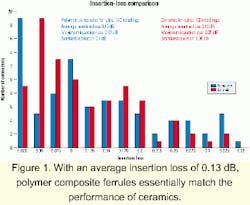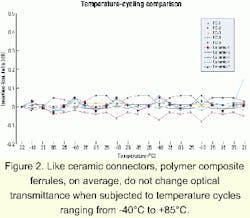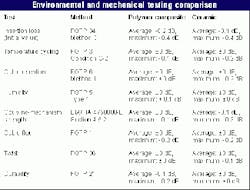Popularity of polymer ferrule fiber-optic connectors
Extensive tests demonstrate that polymer composite technology is comparable to ceramics in fiber-optic connection capability.
HERB CONGDON, Tyco Electronics
In years past, the premises cabling industry was skeptical of polymer composite connectors, particularly when it came to reliably supporting optical-fiber premises cabling infrastructures. But due to significant material and manufacturing improvements over the course of the past five years, this bias no longer has any legitimacy.
In fact, polymer composite connectors have achieved performance parity with their ceramic counterparts. Not only is that true for insertion loss, but also for all key parameters, including temperature cycling, durability, and repeatability. Today's polymer ferrule connectors exceed all the Optical Fiber Cabling Components Standard TIA/EIA-568B.3 specifications and maintain cost advantages and wider availability, which is critical in the face of the booming demand for optical-fiber premises cabling systems.
There is another equally important attribute of today's polymer ferrule technology advances. Because polymer composite material can be easily molded into shapes other than the traditional cylindrical design required by ST and SC connectors, there is much more flexibility in accommodating alternative connector designs. For example, the same performance advantages now offered by polymer ferrules can be applied to higher-density MT-RJ (two-fiber termination) and MPO (12-fiber termination) connectors that feature a rectangular design. As market demand for connectors continues to outstrip supply, the emergence of polymer alternatives for ST and SC connectors and the multifiber capabilities of the MT-RJ and MPO connectors could not come at a better time.
To confirm that polymer composites can match ceramics in fiber-optic connection capabilities, Tyco Electronics performed a series of industry-standard test procedures to determine insertion loss, temperature cycling, cable retention, humidity, cable flex, and twist.
Testing for insertion loss was performed according to TIA/EIA specification RS-455-34, Method C. The cable's initial optical power was recorded before cutting and terminating. The test involved cycles of mating, unmating, cleaning, and measuring optical power for polymer and ceramic materials.
As shown in Figure 1, the average insertion loss of polymer composite connectors and ceramic connectors differs, on average, by only 0.01 dB. This difference is within measurement error and does not affect network performance. With an average insertion loss of 0.13 dB, far better than the TIA/EIA-568 specification of 0.75 dB, polymer composite ferrules essentially match the performance of ceramics. Insertion loss alone, however, is not a sufficient metric.One way to evaluate the tolerances and material suitability is exposure to temperature extremes. In terms of temperature cycling, polymer composite and ceramic connector performance is equal (see Figure 2). Both ferrule materials, on average, do not change optical transmittance when subjected to temperature cycles ranging from -40°C to +85°C.
In addition to insertion loss and temperature cycling, several other tests were conducted to compare the environmental and mechanical characteristics of both materials. The Table on page 97 summarizes these tests and shows that polymer composite connectors on average performed the same as ceramic in cable retention, humidity, cable flex, and twist. Polymer composite outperformed ceramic in coupling-mechanism strength and showed only a difference of 0.1 dB for durability after 500 matings.
To achieve optimal network performance, every fiber-optic connector must control three main causes of insertion loss-lateral displacement, end separation, and angular misalignment:
- Lateral displacement occurs when the fiber axes don't match. To eliminate this problem, the fiber-optic connector must align the fibers on their center axes.
- End separation causes two types of insertion loss. One is due to what's known as Fresnel reflection loss-the result of the difference in refraction between the two fibers and the intervening gap. The second type of loss for multimode fibers occurs when the optical signal exits the first fiber and misses the acceptance cone of the second fiber. Connectors avoid end separation problems by bringing fiber ends together and eliminating any gap.
- Angular misalignment occurs when the ends of mated fibers are not perpendicular to the fiber axes and perpendicular to each other during engagement. The losses result when one fiber is angled away from the other. Angular misalignment can result from a cocked connector or improper fiber cleaving or polishing.
Early polymer composite connectors were inconsistent, partly from having to drill the fiber hole in the ferrules. Even laser drilling failed to consistently meet the exacting requirements to minimize insertion loss for fiber-optic systems. Additional factors have been adhesives and ultrasonic welds that caused variations in the dimensions of the ferrule joined to the connector body. These inconsistencies become evident during temperature cycling when a higher insertion loss is measured. Early polymer materials were not generally as durable as ceramic and tended to have performance that degraded after a few mating cycles.
Today's polymer composite connectors resolve each of these problems. In some polymer ferrule connectors, a precise molding technique has been devised to encapsulate the ferrule in the connector body without adhesives or ultrasonic welds to retain alignment. Overmolding the connector body to the ferrule creates a strong seal that provides protection from delamination, alignment inconsistencies, and wide variations in temperature. Drilling has been eliminated altogether by molding the precision fiber hole in the ferrule itself.In addition, polymer composition has been reformulated to increase durability. As a result, polymer composite connectors now retain high performance through 500 cycles, which meets TIA/ EIA-568 specifications and all practical application requirements. And with reformulated polymer, optical transmissions can be maintained in temperatures ranging from -40°C to +85°C to provide ultra-reliable connections.
As a result of these significant improvements, the fiber-optic premises-cabling industry can de ploy polymer ferrule connectors with the same confidence as their ceramic counterparts.
Polymer ferrules are being deployed in record numbers, partly because the high-precision molding processes can be used for symmetrical and non-symmetrical ferrule designs. The ST and SC ferrules are cylindrical in cross section and thus symmetrical in all radial directions from the ferrule centerline. The ceramic ferrules for these connectors can be shaped in a complex process of abrasives and measurements. How ever, it is difficult to accommodate more than one fiber hole in the machined ferrules.
Molded polymer ferrules are not similarly constrained. The shape of the ferrule can be cylindrical or rectangular (or any shape for that matter). The number and placement of fiber holes is similarly flexible. These factors have contributed to a rise in the number of multiple-fiber ferrules, which are capable of terminating many fibers. As the network electronics have evolved into smaller and smaller units, the need for fiber-connection density has grown. Single fiber ferrules have become limiting due to the amount of board space required to house one or more of these connectors. Further, the lower-density, single-fiber connectors pack patch panels full, so rack space is becoming constrained. The higher density of polymer composite ferrules-terminating 2, 4, 8, 12, or even 24 fibers in a single ferrule-is a welcome innovation in today's market.
The primary ferrule design used for multiple fibers is the MT, a molded rectangular ferrule with two guide pin holes and a number of fiber holes. The designs most commonly used today are the MT-RJ ferrules, terminating two fibers, and the MPO ferrules, terminating 12 fibers. Both of these connector types are recognized in industry standards.
The MT-RJ ferrules and connectors offer the two-fiber connectivity in a space less than that of a single SC connector and smaller than half that of the SC duplex connector.Two fibers in a single small connector is the most popular option for the private-network market, with more than eight million fibers terminated in these connectors.
The MPO connectors offer an even higher-density option. In about the same amount of space as an MT-RJ connector, 12 fibers can be terminated. Imagine connecting 12 fibers with a single push and click. The simplicity and small size of the MPO connector has enabled "plug and go" technology: fast, simple, and flexible fiber terminations. Trunk cables can be terminated in MPO connectors for easy cable routing and fast installation. In minutes, 72 fibers or more can be connected to the network.
Polymers have come a long way since the days of the "one word-plastics" advice given to Dustin Hoffman in "The Graduate" 35 years ago. Today, the ability to mold polymers and their demonstrated performance in real-world and accelerated testing has produced new connector technologies. These new connector technologies offer improved density advantages without sacrificing performance.
Herb Congdon is director of global systems marketing at Tyco Electronics (Harrisburg, PA).



